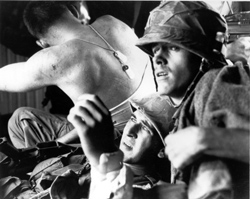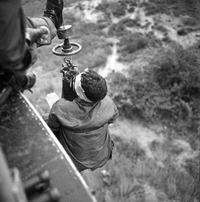The Dustoff Missions


The face of War-- Corporal Larry R. Miklos, center, and an unidentified corpsman look in horror as an enemy machine gun fires at the medevac helicopter in which he is riding. Miklos an artillery forward observer, was wounded during an enemy ambush while on a search and destroy mission south of DaNang on 1 September 1967.
(Brigadier General Edwin H. Simmons Collection [VA020855])
Dustoff missions were generally intense and dangerous. The pilots and crew were often called into remote areas to pick up soldiers, sometimes severely wounded, in areas where the battle still raged. Often the Dustoff crew would be subjected to small arms and rifle fire from the enemy and on occasion missiles and rockets.
In addition to the regular missions, Dustoff crews flew two types of missions that were particularly dangerous: night missions and hoist missions. Night missions were dangerous because the lights helped the enemy zero in on their target. The Dustoff pilots would often run at night with their lights out so they would not be targeted by enemy fire. However running without lights was dangerous to the helicopter and crew; they could crash into trees and other obstacles they could not see in the dark or even misjudge the distance on landing and crash into the ground. The men at the landing zone were in danger of being shot by the enemy because they used lights to guide the helicopter to the landing zone. Because of the added danger only units with priority casualties, ones where loss of life or limb was imminent would call in a medevac at night.
Hoist missions involved evacuating a wounded soldier from an area where the helicopter could not land, usually because the jungle canopy was too thick to fly through. The Dustoff helicopter came equipped with a hoist capable of holding up to 600 pounds. The crew chief and medic would lower either a litter or a jungle penetrator, a kind of foldable seat, to the ground and the wounded soldier would be strapped into the device and raised up into the helicopter.
During a hoist mission the pilots would have to keep the helicopter hovering in one spot until all of the wounded were safely inside the helicopter. Hovering poses several problems for a helicopter crew. First, it is very difficult to keep a helicopter steady for a long period of time. Often the pilot and aircraft commander would switch off flying at timed intervals to reduce the stress related to the difficult flying. Second, sitting in one place for a long period of time increases the chances of the enemy being able to hit the target, thus increasing the chances of the Dustoff being shot down.
Hoist missions often took a long time. If the unit on the ground did not know how to use the equipment, the medic or crew chief would have to be lowered to the ground to show them the proper way to secure the patient. Then they would have to ride back up to the helicopter and send the hoist back down for the wounded. Also the jungle penetrator could only hold two American or three Vietnamese men. If there were numerous wounded the hoist would have to be lowered and raised many times. Usually hoist missions were done with gunship support to help draw and suppress enemy fire.
Probably the most hazardous were night hoist missions because during a hoist mission of course you’re a sitting duck and if the guys on the ground were savvy enough, and they sometimes were, they would wait until you had your wounded about halfway up on the hoist and that’s when they’d start shooting at you, knowing that there is nothing that you can do.
- Robert Eaton, Pilot for the 57th Medical Detachment [Oral History #OH0201], Transcript page 19, lines 2-7.
(listen part 1; listen part 2; listen part 3;
read; more information)
Hoist missions are very, very dangerous. Hoist missions at night are beyond very, very dangerous."
- Ernie Sylvester, Pilot for the 57th Medical Detachment [Oral History #OH0240], Transcript page 31, lines 14-17.
(listen part 1; listen part 2; listen part 3; read; more information)
Vietnam Center & Sam Johnson Vietnam Archive
-
Address
Texas Tech University, Box 41041, Lubbock, TX 79409 -
Phone
(806)742-9010 -
Email
vnca@ttu.edu

